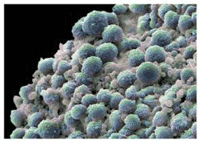 Dr. Singh’s study was one of the ‘biggies’ left. A murine retrovirologist at the University of Utah and the ARUP labs who had been studying (and finding) XMRV in prostate tissues, Dr. Singh started her CFS study about a year ago. Not only did it involve an expert in the field but Dr. Singh was working in tandem with one of our top ME/CFS physicians, Dr. Bateman and the Lights; it was an exciting study.
Dr. Singh’s study was one of the ‘biggies’ left. A murine retrovirologist at the University of Utah and the ARUP labs who had been studying (and finding) XMRV in prostate tissues, Dr. Singh started her CFS study about a year ago. Not only did it involve an expert in the field but Dr. Singh was working in tandem with one of our top ME/CFS physicians, Dr. Bateman and the Lights; it was an exciting study. The study was designed to account for many of the confounding factors such as patient characterization (CFS patients or not?), geographic locations (different variants of XMRV), clinical samples used (both healthy control and patient samples treated the same), blinding and other methods – which could have contributed to the negative results in other studies. The study was impressive on and an August 2010 article questioned whether it was, in fact, the best XMRV study underway? (See “The Best XMRV Study? Dr. Singh Talks!” .
There were a number of encouraging early hints. First an initial smaller study was turned into a much larger second study – a seemingly clear signal that something had been found. A patent filed by Dr. Singh in association with ARUP indicated that indeed she had found XMRV and not just in CFS but in breast cancer and other disorders and in several different types of tissues and had gone so far as to distinguish antibody tests that did and didn’t work well. In an interview she stated that, given her extensive work with MLV’s, she wasn’t surprised at all that other researchers were having so much trouble. The stage seemed set for her to validate the WPI’s results.
But then the study dragged on and on…and some hints suggested that the issues were more complex than she had envisioned. It was difficult to tell, given the tight-lipped approach taken by all the participants if there were big problems or if Dr. Singh just taking a really comprehensive approach to a complex subject? Both it turned out were true. Dr. Singh did believe she found XMRV early on but a closer examination suggested that contaminated reagents/robotic equipment were the cause and the study was large and complex (a 36 pager) with no less than 9 tests looking for XMRV.
Amy Dockser Marcus reported Dr. Alan Light, one of the co-authors of the study, stated “We basically did everything we could think of to come up with a positive result”
 Clearing Up Past Problems – In the introduction of the study Dr. Singh noted a plethora of problems in earlier studies -some of which had not, to my knowledge, been noted before. They included, in addition to those noted earlier small numbers of controls, lack of blinding, unsure limits of detection, lack of culture tests, lack of controls designed to flag contamination, low numbers of negative controls, lack of positive XMRV patients. This study eliminated all of those considerations and in his blog Dr. Racaniello called it the “most comprehensive study to date”.
Clearing Up Past Problems – In the introduction of the study Dr. Singh noted a plethora of problems in earlier studies -some of which had not, to my knowledge, been noted before. They included, in addition to those noted earlier small numbers of controls, lack of blinding, unsure limits of detection, lack of culture tests, lack of controls designed to flag contamination, low numbers of negative controls, lack of positive XMRV patients. This study eliminated all of those considerations and in his blog Dr. Racaniello called it the “most comprehensive study to date”.
Size and Shape – With 105 people with CFS and 200 healthy controls and 14 people who had repeatedly tested positive for XMRV by the WPI this was a large study. The cohort, provided by Dr. Bateman, was a good one with many seriously ill patients who must have matched up well with those in the WPI study. Sixty-eight percent were females and all but five met both the Fukuda definition and the Canadian Consensus Criteria. They were not fat (?) (BMI 23.5) and the average age was 34.6. Most (72%) had an infectious onset and with an average duration of 16 years, most had been sick a long time. About 15% reported a family history of ME/CFS/Fibromyalgia.
Functional assessment questionnaires indicated that they had high levels of physical disability that impaired them in every sphere of their life.
Methods – Dr. Singh developed her own qPCR and antibody tests and used several of the tests used in the original Lombardi paper and the Lo/Alter paper to test the Utah patients. (In an interview Dr. Singh explained qPCR tests cut down the possibility of contamination because, unlike the nested PCR, it was only run once.) She used her qPCR tests to hone in on four different regions of the virus and adapted, with Dr. Frank Ruscetti’s ‘extensive help’ the WPI’s original culture test (Dr. Ruscetti was a co-author of the original paper). The culture test lasted, as per Dr. Mikovits instructions, six weeks.
Dr. Singh used the nested PCR protocol (gag sequence) in the original Lombardi paper and the protocol Alter/Lo used to test for XMRV/MLV’s in the 14 patients who had repeatedly tested positive at the WPI as well as all her tests. The positive patients, then, were tested for XMRV in nine ways; 4 qPCR tests developed by Dr. Singh, two antibody tests, a Ruscetti culture test, nested PCR (gag) (Lombardi) and nested PCR (Lo/Alter).
Results – She was unable to detect XMRV or MLV sequences (aka the Lo/Alter study) in any of the Utah ME/CFS patients, the positive patients provided from the WPI or the healthy controls samples using any of these tests.
Dr. Racaniello strongly endorsed Dr. Singhs results stating
WPI Test Produces Some False Positives – When Dr. Singh used the PCR assay used in the Lombardi paper and the PCR assay used in the Alter/Lo paper, however, about 5% of healthy controls and people with ME/CFS tested positive. Questioning whether the test might have picked up a laboratory produced plasmid she did a qPCR test that could determine whether she had found a wild type virus or the infectious clone she had produced to run the tests. The test indicated she had not picked up her laboratory plasmid.
She then created a ‘remarkably sensitive’ qPCR test that looked for IAP sequences to check for mouse DNA and didn’t find any mouse DNA either!
Had the WPI’s assay really picked up XMRV (albeit in low levels in both CFS patients and controls)? After noticing an odd pattern; upon retesting the 5% level of positive results remained the same but that different samples were testing positive she dug deeper.
Contaminated Reagents – First Dr. Singh tested 36 uninfected LnCaP cells used for culturing and found two of them were positive for XMRV using the WPI’s nested PCR but not with her qPCR or the IAP test. (Since they had not been infected with XMRV all should have been negative). Then she began to test different components of the actual test itself and found that two enzymes (Taq polymerase and Platinum Taq polymerase from Invitrogen) tested positive for mouse DNA. When she began testing different batches of the polymerases she found that four different batches were contaminated. Repeated testing of another polymerase from Amplitaq, on the other hand, indicated that it was clean.
 A Different Course of Contamination – The authors noted that the ‘detection of XMRV in the blood is fraught with difficulties” and added their own strange story of accidental contamination to the mix. They initially used a biorobot that had, some months earlier, been used to extract DNA from XMRV positive tissue cultures. Despite using ‘sterile, disposable reagents’ traces of XMRV, to their surprise, still lingered in the biorobot several months later and ended up producing the early false positives. Once Dr. Singh abandoned the biorobot (in this case men were better than machines) the positive results stopped. On a positive note, for their study, they noted that their ability to find even the trace amounts of XMRV left behind indicated how sensitive their tests were.
A Different Course of Contamination – The authors noted that the ‘detection of XMRV in the blood is fraught with difficulties” and added their own strange story of accidental contamination to the mix. They initially used a biorobot that had, some months earlier, been used to extract DNA from XMRV positive tissue cultures. Despite using ‘sterile, disposable reagents’ traces of XMRV, to their surprise, still lingered in the biorobot several months later and ended up producing the early false positives. Once Dr. Singh abandoned the biorobot (in this case men were better than machines) the positive results stopped. On a positive note, for their study, they noted that their ability to find even the trace amounts of XMRV left behind indicated how sensitive their tests were.
The authors believe contamination was probably responsible for the Lombardi papers results. They noted that culturing, the method that has worked best at the WPI , was ‘especially vulnerable to contamination’. Their ability to find mouse DNA in a PCR reagent which was developed using a mouse monoclonal antibody was not surprising but mouse DNA’s appearance in a reagent developed without mice was surprising.
They followed the lead of some other researchers in proposing IAP tests were the best contamination test. Except for handling (ie testing) samples more frequently they were unable, however, to come up with a good explanation for the strikingly different PCR results between the healthy controls and the patients in the original study. They noted that all ‘possible – and seemingly not possible’ sources of contamination (reagents, equipment, etc.) should be checked.
They also noted, however, that serological (ie antibody) results are not nearly as susceptible to contamination but are susceptible to false positives if they cross-react to other pathogens or other proteins. Their two antibody tests did not reveal XMRV was present and they suggested this meant the positive results in the original study may have been due to a cross-reaction to another virus or protein and not to XMRV.
Strong Conclusions – Drawing on the negative tests of the formerly positive patients the authors went so far as to say that they ‘feel that XMRV is not associated with CFS’ not just in Utah but anywhere, and therefore felt ‘forced to conclude’ that prescribing antiretroviral drugs is ‘insufficiently justified’ and ‘potentially dangerous’.
They also noted that there is a ‘wealth of data’ suggesting infectious involvement in ME/CFS and, that efforts in that area should continue.
 Where is XMRV Now?
Where is XMRV Now?
The most problematic finding for XMRV is not that researchers are finding it but declaring it to be a contaminant (although that has happened in three published studies and one unpublished one) but that once again, they are simply unable to find evidence of the virus even in low levels in CFS patients and other disorders. At this point the question where it came from – the product of a laboratory accident or an escape from mice – is somewhat irrelevant. Researchers have to find the virus in people with ME/CFS before they can associate it with the disease.
Since the Lombardi paper was published in Oct. 2009 none of the 13 ME/CFS studies and only 1/14 studies on other disorders (not including prostate cancer studies) have found XMRV. The really hard fact to confront is that none of the 24 studies that have looked XMRV in the blood in over the past year and a half in 9 different disorders since the Lombardi paper have found any XMRV at all.
Unpublished reports of positive studies include the WPI’s London study, Dr. Meirleir’s study and Dr. Cheney’s VIP Dx study. Unless they are done by reputable antiretroviral labs, however, the De Meirleir and Cheney findings, at this point would probably count for very little when specialists in the field are unable to find the virus.
The Big Question remains why the WPI was able to find XMRV in such high numbers in the Lombardi study of Oct 2009 and why few others have. The lists of proposed reasons XMRV was not being found is a long one and includes the wrong kinds of patients, wrong tests, not using culture, incorrect storage procedures, incorrect sampling procedures, freezing/refreezing samples, no antibody tests, wrong annealing temperatures, not calibrating magnesium levels….All of these have been more or less definitively at one time or another stated to be the reason or a major reason why XMRV was not being found.
Almost all of those have been resolved. The sampling/storage questions were resolved in the second part of the BWG study. The Satterfield study addressed questions with PCR (annealing temperatures, magnesium levels) and antibodies. The Singh study was able to cross off wrong patient cohort, wrong tests, not using culture, geographical differences in viral spread or genetic variation. Culturing was a big issue but Dr. Singhs culture tests created in ‘extensive’ collaboration with Dr. Ruscetti suggested that lack of culturing was not the answer either.
What is Left? A good question is ask now is what other than contamination that could possibly explain the differing results? Not using a wild-type virus to calibrate the PCR test has been put forward but the CAA article titled the “The Iteration of X” which noted that Dr. Singh’s clone, which was a combination of two VP62 plasmids, actually produces an infectious, wild-type virus in culture would seem to eliminate that argument.
A Smaller Bench – The strength of the original study has long since faded with researchers finding ways to explain each of the findings away. (The disparate results between the healthy controls and patients is still the most difficult to explain). Dr. Coffin, an early supporter is gone. It was hoped that Dr. Singh, a specialist in these viruses, would save the day but that hasn’t happened. Dr. Racaniello has been careful to leave the door open but went so far this time as to imply that the research community has made up its mind on XMRV and that the WPI should track down the source of contamination in their lab so that the issue does not linger in the ME/CFS community.
The CFIDs Association article suggested that the research community is not so convinced as that as they reported that the two big studies underway, the Lipkin and BWG study, will continue. The results of the BWG study should be in by the end of summer and the Lipkin study, which is still gathering approvals, will take much, much longer.
XMRV’s bench, so to speak, is getting smaller and smaller yet it does still contain important players in retroviral research. None of the co-authors of the original study which included Dr. Silverman, Dr. Ruscetti and of course, Dr. Mikovits, have disavowed the original study results and both Dr. Mikovits and Annette Whittemore appear recently to be entirely confident about their results. It’s almost inconceivable that the WPI has not, in the face of all this controversy, been doing extra internal testing involving controls to ensure that they are on the right track. Those results could underlie their confidence.
What could these studies still be doing wrong after all this time? That answer will have to come from the WPI and the original study authors. The WPI has not, as yet, made an official response to the Sin/Singh study.
More to Come – Meanwhile there are still major studies to come. The Glaxo-Smith Kline/CAA study and University of Alberta studies are long overdue. The results of a Levy culture study are expected soon. Dr. Joliceur in Canada and the NCI are looking at WPI positive patients, and, of course, there are the two ‘biggies’; the BWG and Lipkin studies.

